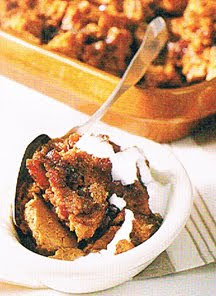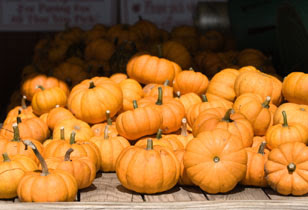Still, pumpkins were typical fare at the time. The word squash comes from the Algonkian askutasquash, which literally means ‘the green things that may be eaten raw.’ Roger Williams, founder of the Rhode Island Providence Plantation and a friend of the Wampanoag tribe, documented this in his 1643 work, A Key into the Language of America. Askutasquash, he noted, came in “several colours” and were the native peoples’ “vine apples.” Both the seeds and flesh of pumpkins were eaten, sometimes after being roasted in embers.
A few decades later, in a book detailing his 1638 and 1663 visits to America, John Josselyn gave a recipe for an “ancient New England standing dish” featuring stewed pumpkin. (Standing was used in the same way we employ it in ‘standing invitation’ today.) Some folks weren’t really pleased to be eating pumpkin so often, as a popular bit of doggerel from the period suggests: “We have pumpkins at morning./Pumpkins at noon./If it were not for pumpkins/We should be undoon.”
Tip: If you’re interested in other recipes especially suitable for Thanksgiving or other fall menus, check out my Autumn Fruit and Vegetable Bisque here. Or look for my very moist and succulent pumpkin-cranberry quick bread here.
Pumpkin Bread Pudding
 This recipe and photo are from a recent book of mine, The All-American Dessert Book. The recipe was inspired by a pumpkin bread pudding in a landmark 1796 cookbook called American Cookery, by Amelia Simmons.The pudding has a soothing pumpkin-and-spice flavor and enticing aroma, and it makes a fine, never-fail substitute for pumpkin pie at Thanksgiving. It’s also ideal for fall and winter brunches. I’ve baked this pudding on a number of television shows and in cooking classes; it’s always a huge hit!
This recipe and photo are from a recent book of mine, The All-American Dessert Book. The recipe was inspired by a pumpkin bread pudding in a landmark 1796 cookbook called American Cookery, by Amelia Simmons.The pudding has a soothing pumpkin-and-spice flavor and enticing aroma, and it makes a fine, never-fail substitute for pumpkin pie at Thanksgiving. It’s also ideal for fall and winter brunches. I’ve baked this pudding on a number of television shows and in cooking classes; it’s always a huge hit!
The pudding is great served with my easy Brown Sugar Orange Sauce, too.
Tip: If preparing this recipe for a crowd, you may want to double it. Bake it in a 9-by-13-inch baking dish (which will be very full) for 35 minutes, then sprinkle on the brown sugar and continue baking until the center is firm when lightly tapped, 20 to 30 minutes longer.
4 large eggs
1 cup packed light or dark brown sugar, plus 3 tablespoons for sprinkling on pudding
1 cup whole or low-fat milk
1 cup light or heavy (whipping) cream
1 15-ounce can solid-pack pumpkin (not seasoned pie filling)
2 3/4 teaspoons ground cinnamon
1 teaspoon ground ginger
3/4 teaspoon ground allspice
5 1/2 cups cubed (1/3 inch) crusty French or Italian bread, crusts removed
3/4 cup dried, sweetened cranberries, optional
Brown Sugar–Orange Sauce for serving (see recipe archives)
Ice cream or lightly sweetened whipped cream for serving, optional
Position a rack in the middle of the oven and preheat to 325 degrees F. Lightly grease a 7-by-11-inch or 9-inch square baking dish or coat with nonstick spray.In a large bowl using a wire whisk, beat the eggs until frothy and smooth. Add the brown sugar, whisking until the sugar dissolves. Whisk in the milk, cream, pumpkin, and spices until completely blended and smooth. Stir in the bread cubes and cranberries. Turn out the mixture into the dish, spreading to the edges. Lay a sheet of baking parchment or wax paper on the surface and press down to keep the bread submerged. Let stand for 10 minutes. Peel off and discard the paper.
Bake for 25 minutes. Sprinkle the remaining 3 tablespoons brown sugar over the pudding and continue baking just until the center of the pudding is firm when lightly tapped, 12 to 17 minutes longer. Transfer to a wire rack. Let cool for at least 15 minutes. Serve spooned into bowls.
Drizzle with brown sugar-orange sauce and/or garnish with scoops of ice cream or dollops of whipped cream, if desired.The pudding will keep, covered,in the refrigerator for up to 4 days. Reheat to very warm just before serving.
Makes 6 to 8 servings.



I think this would be really good for breakfast, maybe with some cubes of cream cheese thrown in just for anyhow. Thanks for the inspiration.
This recipe is amazingly easy and foolproof, yet is always popular. It is especially nice with the sauce (in my recipe archives). Since the bread is cubed, it doesn't really look like baked french toast. It actually tastes a bit like pumpkin pie. I plan to take it to Thanksgiving dinner and serve in place of pumpkin pie. (I'm using gluten-free bread so my wheat-allergic daughter-in-law can have some.)
I just recently started loving bread puddings and baked french toast. What would you say is the difference between the too? Sort of like the difference between a muffin and cupcake? This looks wonderful!